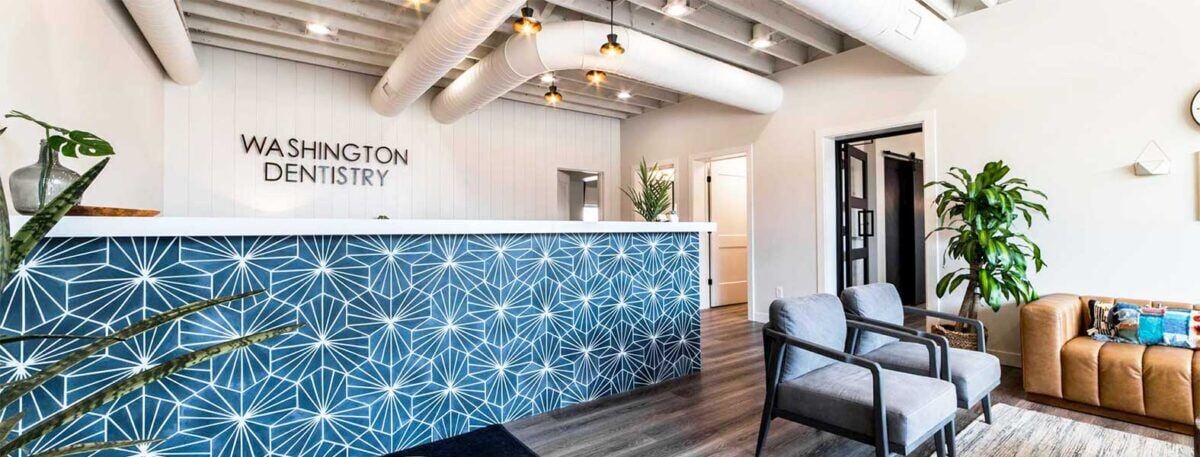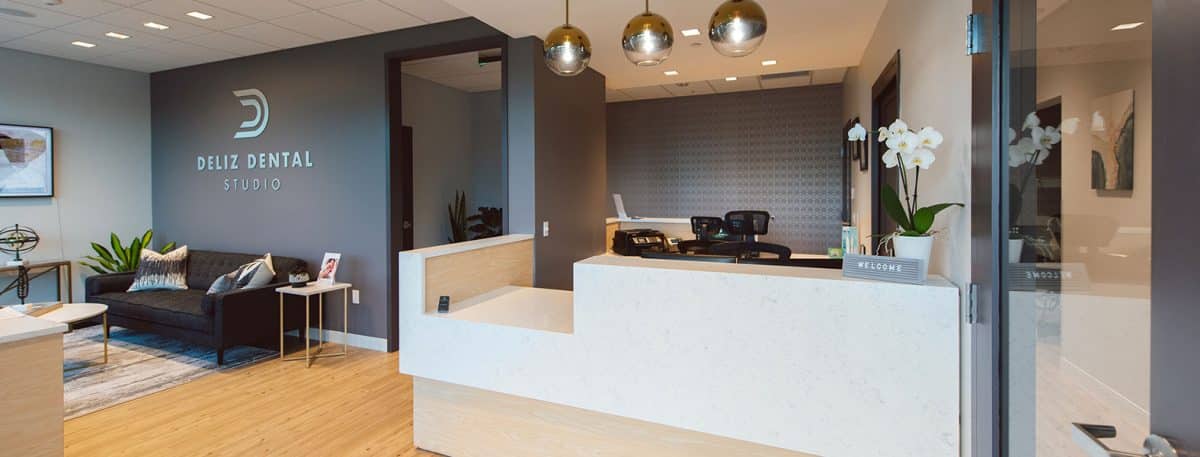Five phases of dental office front desk design
August 21st, 2023
5 min. read

Here's the harsh truth about front office design. Most dentists aren't confused about how their front desk should be organized... but they should be.

When not planned properly, a front desk can bottleneck growth.
Most dentists don't fully understand that as your practice grows, almost everything changes. How you organize the front desk needs to change or else it becomes an obstacle to growth. For simplicity, I've organized the evolution of dental office front desks into five phases. This isn't a perfect science, but it is based on 25 years of designing some of the most efficient practices across North America, and I believe it's a useful framework for thinking about where your front desk may need to evolve so that it is not actually standing in the way of your overall practice growth.
Phase 1: The Everything at the dental office front desk
I know that this will sound crazy to many of you, but the vast majority of dental offices have a front desk that is the single point for all things administrative in the practice. Scheduling, billing, insurance, phone answering and even financial arrangements are done there. Quite honestly, if you are growing fast and have an official office manager for this type of office, the only change that he or she is likely to suggest to you is a room for him or her to hide in to avoid the chaos that is going on at that desk! ...Hiding does not seem like the appropriate plan actually...
However, once you begin to contemplate what you should do to move beyond the front desk as the center of the dental universe, you need to think about how the situation occurred in the first place. It's really quite simple and it all started with:
- a corded phone that made it so you couldn't go anywhere.
- a chart that you needed to reach every time you worked with patients.
- a giant schedule book.
- all of the snail mail that you received from insurance companies that had to be reconciled ...with the ledger ...in the chart.

In the past, many different functions were tethered to the front desk.
And of course you also had, you know, the patient standing at the front desk with questions about scheduling and billing that could only be answered at the front desk which was the home for all of this stuff. So that's what I'd refer to as Phase 1.
Phase 2: Insurance, banking, and mail handled separately
Most dental office's worth growing have already evolved beyond Phase 1, at least a little bit. They split off the stuff coming to and from the insurance company and the bank and the mail and put it in another room. It's a small but important step. Many times that's where the "manager" moved to. But is that the end of the road? I don't think so.

An elegant example of a contemporary phase 2 front desk
Phase 3: Scheduling and treatment planning move closer to where the dental patient is located

A dedicated space for treatment planning, consulting, and scheduling.
A revolution was forced on the dental profession when we were threatened to comply with electronic records, (which some have still ignored!) Suddenly, there was no chart. Once there was no physical chart, there really could be no effective schedule book. I could do a daylong program on the entire mess that this created and how your computer scheduler is costing most of you probably 30% of net revenue. I'm dead serious. But that ship has sailed. There is no book anymore. There are workarounds for the stupid assumptions that are built into your computer scheduler. So then what's good about not having a book if it is not naturally great at productive scheduling? Well, now you can talk about money and the schedule and the treatment plans in private anywhere. Consultation can be moved to the managers office, the doctors office, or a dedicated consult space. Phase 3 was a big deal!
Phase 4: Treating patients like diners in a high-end restaurant
But Phase 3 thinking still missed some of the power in a distributed patient reload. In Phase 3 we still mostly moved the patient to the place an administrator happened to be! So, the question remains, what are the kind of things that are possible in a Phase 4 practice where you move the office around the patient? Well, when you get to a certain size and a certain amount of intake volume you realize that you never want a patient to enter your office without a warm, personal, and compassionate greeting. This is the maître d' function. It's essential at every great restaurant you go to. A crown can be 10 times the cost of your fancy restaurant dinner. Can we really not budget this function into our practices? But there's actually much more to this.

A warm reception can allay fears and build trust.
Once you fix the problem with the lack of personal attention on the intake side, you also need to do the same thing on the outgoing part of the desk. I'd refer to this as "phones off the desk". It doesn't mean no phones at the desk necessarily but rather, phones almost never used at the desk so that any staff there are immediately ready to attend to those patients actually in your presence rather than the virtual ones with arcane questions about their copayment, etc. on the phone. Committing to this often feels like a big leap and the thought of having coworkers doing patient-centered work while removed from actual patient contact makes many offices nervous. However, in most busy and productive practices there are more patient interactions in a day that do not require physical patient contact than those that do require their physical presence - scheduling, billing, reminders, recall, new patient intake.
Once you study these through this lens, remote location becomes more understandable.

Keep the focus on your patients by creating an area to answer phone calls away from the front desk.
Phase 5: Cozy treatment rooms designed for patient consultation
For many offices that intend to become the best office in town, I'd suggest that you consider a fifth phase of practice evolution. It's not for everyone, and please remember that at Design Ergonomics we design offices in every one of these business models that I've discussed.
In the first phases, patients are dragged through the practice like Henry Ford would have done it on the assembly line. As we move to the 4th and 5th phases, you need to be ready to move the team members to the patient rather than the patient to the staff locations. Think about this for a moment. Especially regarding new patients - over half of the revenue for many thriving offices . These patients don't really know their way around your office even if you show them. And, quite honestly, too many of your offices are a tangled labyrinth that nobody can figure out how to navigate! People hate feeling lost and most people hate being trapped in Consult rooms. You don't want patients making buying decisions while they feel lost and trapped do you? So how do you fix this? By making your treatment rooms sublime - and not just for treatment!

Patient consultation right in the treatment room
If your treatment rooms are quiet, comfortable, and cozy, you can comfortably sit with a patient in a natural orientation when presenting treatment at chairside. This is without question the best place to have important conversations. But to do that you must have a structure where your administrative team can flex to chairside. With that said, I have a word of caution. We hear hundreds of different excuses from office administrators and treatment coordinators as to why this can't be done. And, to be honest, most doctors don’t have the vision to see past these objections. But I can assure you this, and people like Dr. Rod Kurthy and Dr. Robert Cialdini have been saying this for a long time - the place to have a comfortable conversation with a patient is where they are rather than where you drag them to.
So there you have it. Five phases of front desk evolution. And please understand that wherever you may be in the growth of your practice, we’re honored to design whatever type of office fits your goals and desires. We’ve done this thousands of times. But do be ready. Growth happens because of change. Be ready for what’s next. Because, if you plan for it correctly, it just gets better and better.
You may also be interested in:
Topics:





